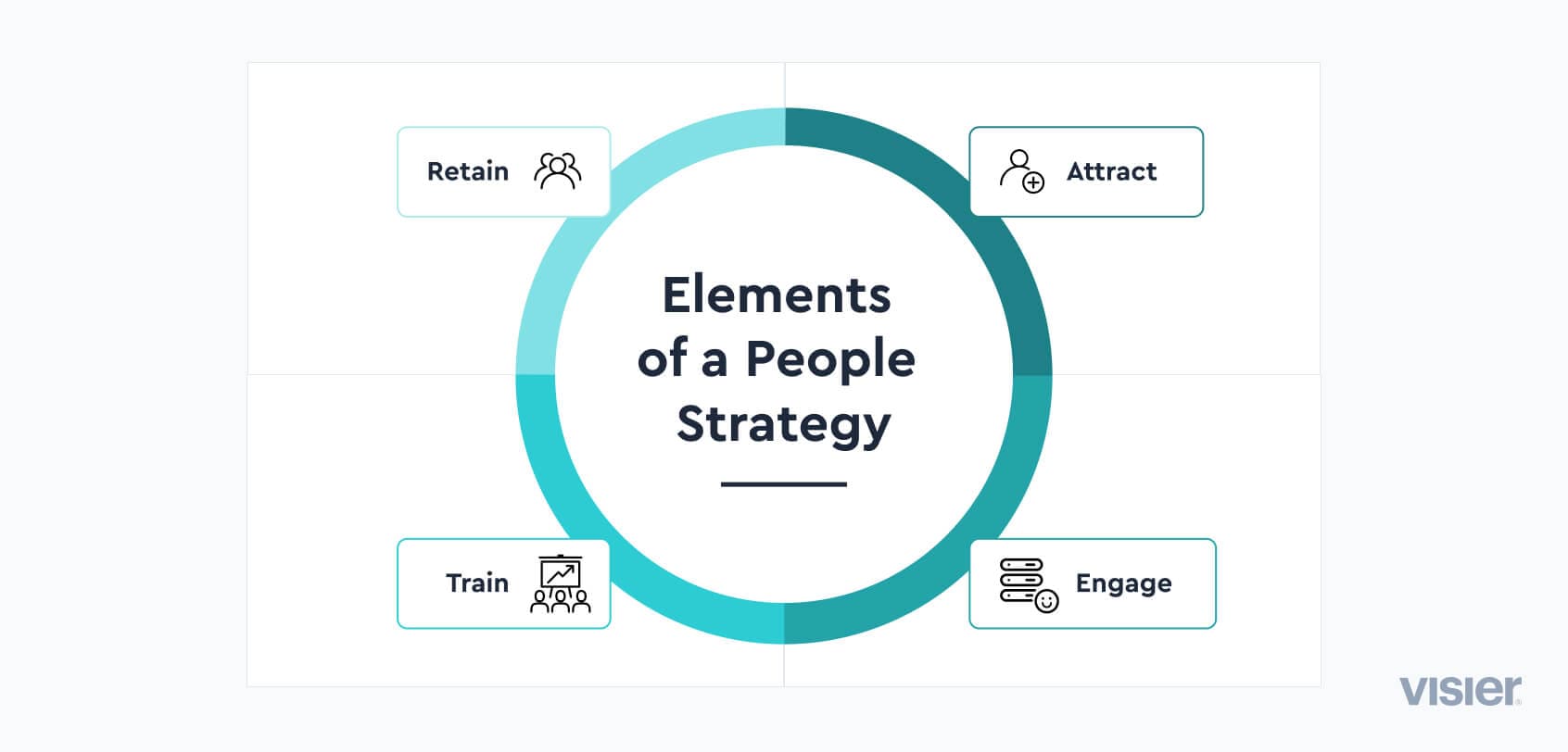HR STRATEGY
Creating an Effective People Strategy
People strategies help organizations hire and retain the best talent possible for their organization. Learn more.
Take a tour
Table of contents
What are people strategies? What are the benefits, pros, and cons of people strategies?What steps should be followed to develop people strategies?What are some examples of effective people strategies? Create and manage more effective people strategies with the right toolsWhat are people strategies?
The most important asset of most modern companies is their people. In a dynamic, fast-paced, information-based economy, it’s smart, hardworking, creative, and passionate people who drive the world’s best companies. It should come as no surprise, then, that one thing all highly successful companies have in common is that they have a people strategy.
Here we take a look at the concept of a people strategy, discuss some pros and cons of those strategies, review the process, provide some examples and go over how Visier can help organizations develop and execute their people strategies.
What is people strategy
Modern companies need exceptional talent to outperform the competition. A people strategy is a company’s plan for how it can leverage the benefits of exceptional talent. This includes all strategies to attract, develop, retain, and engage people in the organization.
While most people may immediately think of the hiring process as a people strategy, this is only one element of a people strategy, albeit an important one. In reality, people strategy takes into account the full lifecycle of employees at a company—from hiring to exit.
Elements of a people strategy
A comprehensive people strategy involves a plan to attract, engage, train, and retain talent. Let’s consider each individually.
Attract
This is the hiring part most people probably think of first when they think of people strategy. That’s somewhat fitting as attracting people is the first phase of a broader people strategy. Of course, you have to have employees before you can engage, train, and retain them.
Attracting talent requires thinking about what an organization’s needs are and whether and how bringing on new staff can address those needs. This might include hiring for specific talent, competencies, or experience, or strategically approaching talent acquisition in an effort to increase diversity within the organization.
Engage
Companies want their employees to be passionate about their jobs. While some employees may be naturally passionate about their line of work, employee engagement doesn’t just happen. Part of a good people strategy involves finding ways to keep employees passionate and engaged in their individual job function and in the work and mission of the organization as a whole.
Train
Ideally, companies will be able to hire exceptional staff who come in the door with all of the skills and experience needed to help the company thrive. In reality, and particularly in a tight labor market and with ongoing technological advancements, employers often have to help close the gap between the skills employees have when they join the organization and the skills they need to succeed now and into the future. Therefore, training is an essential element of any people strategy.
Retain
Turnover is an unpleasant reality in all businesses, and the trend in recent decades is toward shorter and shorter tenures at companies before employees start exploring other options. Employee retention is a major challenge for all organizations, and people strategy is key to that effort. This can come in the form of efforts to boost employee engagement and satisfaction, and is closely tied to things like performance management, compensation, and general employee wellbeing.

What are the benefits, pros, and cons of people strategies?
There are many benefits to creating and implementing a people strategy and few drawbacks, most of which are the result of poor planning and/or execution.
Benefits of people strategy
A people strategy involves thinking deliberately about how to attract, engage, train, and retain staff. In that sense, one of the obvious benefits of a people strategy is that it gets the key stakeholders thinking about these challenges and how to address them. Well-designed and well-implemented people strategies help organizations do better at all four of these key elements of employee management.
Additionally, a people strategy that is effectively communicated to employees sends a clear signal that the organization cares about them and their professional development. It’s a great way to communicate a sense of inclusion and belonging.
As a result, employees often feel more confident in giving their own feedback to their employees, thereby improving dialogue and communications. This helps to address simmering issues before they come to a head.
Overall, a people strategy, if designed and implemented effectively, creates a better, more dedicated, more effective, and more efficient workplace. That kind of improvement won’t just happen on its own.
Having a people strategy in place is necessary to get the best out of a company’s workforce, but—as we’ll discuss in the “cons” section—simply having a people strategy isn’t always sufficient to achieve those results.
Cons of people strategy
It’s hard to come up with any legitimate drawbacks of people strategy as a concept. It makes logical sense that thinking deliberately about how to attract, engage, train, and retain talent is a good idea.
The cons of people strategy, therefore, tend to fall into the design and implementation categories. Not all people strategies are created equal. What may be a great people strategy for one organization may be unworkable for another.
One potential con of a poorly crafted people strategy is that it may conflict with other key corporate strategies. For example, a people strategy may not align well with a broader HR strategy if the staff responsible for creating both strategies are operating in their own silos.
Similarly, a people strategy may clash with a broader corporate initiative to cut costs through reductions in employee training budgets, hiring freezes, or even layoffs.
Finally, overly aggressive people strategies can place additional burdens on staff on top of their existing workloads. For example, a people strategy that requires staff to complete ten hours of training per week could quickly lead to a lack of focus on core duties as well as burnout.

What steps should be followed to develop people strategies?
Creating and implementing a people strategy is a similar process to any other major corporate initiative. Here are the key steps to developing a people strategy that every organization should follow.
Seeking feedback
Feedback is a critical component of developing any type of strategy,and people strategy is no different. Organizations need to seek input from employees, in addition to evaluating their own people data to identify strengths, gaps, and opportunities for improvement. Employee engagement is one key metric that organizations should consider as they’re formulating their strategies.
Feedback should also include consideration of internal and external factors that impact talent needs. For instance, changing customer expectations, increasing turnover, a changing competitive landscape, technological advances, and emerging competition, will all impact the scope and direction of a people strategy.
Defining objectives
A thorough internal and external analysis will drive the development of desired goals and objectives. Effective people strategies need to have associated measurable goals and objectives to help organizations determine whether their actions have the desired positive impact.
Defining desired objectives requires a lot of careful and insightful consideration. It requires thinking about the present and expected future opportunities and challenges and what an organization needs to do to mitigate those challenges and capitalize on those opportunities. It also requires the people strategy team to isolate key metrics that they will track, and to define what success looks like from the outset.
A team that starts its people process with objectives that aren’t meaningful, realistic, or aligned with the broader corporate strategy will run into friction and challenges down the road. And a team that does not benchmark their current state, track relevant metrics reliably, and measure progress against targets will be unable to demonstrate impact from their people strategy.
Evaluating current state
Once a company has its desired objectives in mind, it needs to take an objective and honest look at where the organization and its key pieces sit today with respect to those objectives.
If the objectives are the finish line, the current state is the starting point. The next step in the people strategy process is figuring out how to get from the starting point to the finish line.
For example, a company with a people strategy of employing the most knowledgeable customer service representatives may need to invest heavily in training if its existing customer service staff is not as knowledgeable as the desired end state.
Similarly, a company that desires consistent customer experiences will need to work to ensure that organization-wide service standards and quality controls are adhered to.
Again, having a defined set of metrics to benchmark and track progress against will ensure that organizations can effectively measure and report on the impact of their people strategies.
Considering internal mobility
People strategy will be both externally and internally focused. Considering internal mobility can help organizations develop and maximize the value of existing talent, while identifying opportunities to bring in new talent from outside the organization.

What are some examples of effective people strategies?
People strategy is a big concept, and there are many examples of focused initiatives that fall under this broad umbrella.
One example might be creating growth and development plans for staff that demonstrate high potential. These plans might involve customized training courses, mentorship programs and inclusion in leadership meetings to gain familiarity with executive team members and executive team culture.
Another example might be an organization that implements a diversity and inclusion program to improve its level of diversity and employee engagement.
Or a company might solicit feedback on quarterly employee satisfaction surveys and review the results to consider changes to company policies around flexibility, salary and benefits, professional development, workplace safety and other issues.
Effective people strategies require data and analysis to ensure that the appropriate actions are being taken.
First West Credit Union had tried different interventions to reduce turnover—from pay increases, to better onboarding, to management training. They used data and analysis to help them determine which was most effective and found that upskilling employees through additional training increased revenue significantly—returning $2.5 million on their investment.
Create and manage more effective people strategies with the right tools
Modern organizations live or die largely based on the experiences, skills, and passion of their employees. People strategy is an essential component of every organization’s broader strategic plan.
Unfortunately, many organizations don’t have the headcount or resources on their HR teams to craft a holistic people strategy that plays well with other corporate initiatives and contains realistic and meaningful objectives. In short, HR teams need help. For many, that means onboarding the right tools to help them extend their capacities.
Strategic compensation tools, for example, help keep tabs on employee compensation levels to ensure that they’re competitive with the marketing and inline with employee performance. Retention tracking lets HR teams benchmark turnover at the organization and understand the underlying causes, helping to focus on initiatives that improve employee loyalty. Talent pathways and better managers’ tools help to identify top performers, map desirable career paths for them, and strategically place them in positions of greater influence. And tracking employee satisfaction helps to identify key employee engagement benchmarks, and uncover underlying problems or opportunities.
![The Future of People Management [CARD IMAGE ASSET]](https://images.ctfassets.net/lbgy40h4xfb7/4AcnFW1LaD10lL0kGPbRR7/c4d79dade48028b0d81f334ea202ea49/future-of-people-management-resource-card.jpg?w=1200&h=627&fl=progressive&q=100&fm=jpg)
![People Strategy: What Is It and How to Make One [CARD IMAGE ASSET]](https://images.ctfassets.net/lbgy40h4xfb7/6P7pKknVt5uQhUbcTFYsH3/bb2f8bbbbfe9763024a46f819c007460/people-strategy-blog.jpeg?w=1200&h=700&fl=progressive&q=100&fm=jpg)
![Building the Foundation of a People-Powered Organization [RESOURCE IMAGE ASSET]](https://images.ctfassets.net/lbgy40h4xfb7/7ei4L75NiAForVtLE9q8sS/176a00c8a71a65a8261170f6fd5c10b5/2022-peoplecloud-resource-card-2.jpeg?w=1200&h=700&fl=progressive&q=100&fm=jpg)